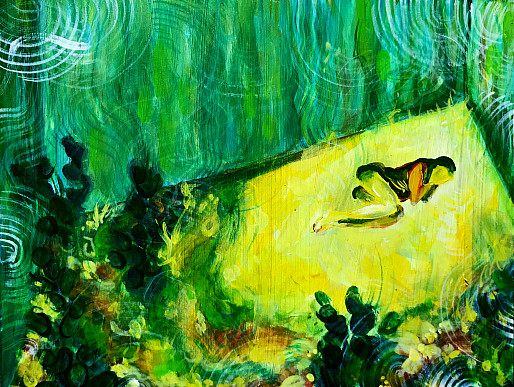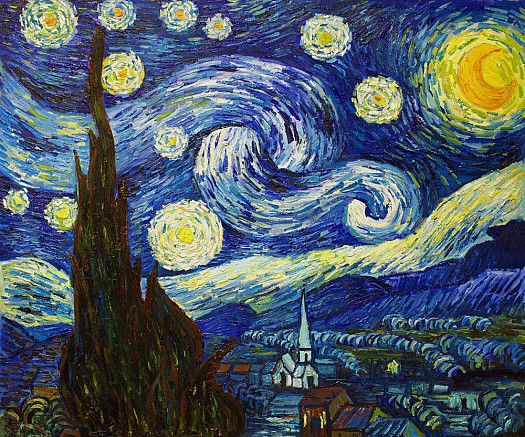Julia Little ’24

One with the Stars
Ever since I was little, I have struggled to fit in places. I have never been super outgoing, and making friends wasn’t the easiest thing for me. Because of this, I’ve spent a lot of my life feeling lonely. I feel like people mix up the ideas of “being alone” and “being lonely”; I still do it too when trying to understand my own feelings. From what I understand, being alone means that you don’t have company at the time, you are quite literally alone, while being lonely is a feeling that can happen to you at any time, even if you are in a room filled with people. Being alone can be fixed; being lonely normally cannot. This feeling has lived with me for as far back as I can remember. It’s a feeling that I can’t pinpoint or describe, and having it makes me feel guilty. As far back as preschool, I can remember trying to be involved in friend groups only to be left out, which caused me to become sad and hide behind the playhouse during lunch time. In elementary school, my dad was the PTA President, which meant he was around for most of the time I was in school there. I often found myself hanging out with my dad and helping him with things because I wasn’t able to make friends or connect with people in my class. Years upon years of being left out and ignored wasn’t an easy thing to deal with—it felt like everyone around me had mastered the art of making friends and being likable while I was just underneath them all, drowning.
Although I had much more success making friends as I got older, I often still felt really disconnected. I constantly felt like I was such a burden to the people around me, and I normally ended up separating myself from people because of that. It was so frustrating because feeling lonely all the time wasn’t something I consciously chose to feel, it was just always there, and I couldn’t get rid of it. It was a feeling that has isolated and affected me in many ways that still haunt me to this day.
This feeling often overwhelmed me and made it hard for me to go about my days. It caused streams of negative thoughts, diminished my self-esteem, and made my ability to connect with people nearly impossible. As time went on, this feeling didn’t go away or subside in the least bit, and it began to feel out of my control. After a year and a half, I began seeing a therapist, and learned that what I thought was just a feeling of loneliness was actually depression. Although I was relieved to finally know what was wrong, at the same time I felt even more weird and isolated than I had before. I was now considered “mentally ill.” I felt like I was carrying around all of this extra weight every day. Sometime after being diagnosed, I realized that this was something I had to learn how to live with. I began searching for people, places, and things in the world that made these overwhelming feelings I had more bearable.
Throughout middle school, I worked hard to fill up any free time I had because I found that was the best way to distract myself from any negative or intrusive thoughts that would pass through. If I was at school, you could normally find me in the drama, art, or yearbook room, and after school I was most likely doing something with the community theatre. I was constantly trying to be a part of groups and clubs because I longed to have the feeling that I fit in somewhere. However, it wasn’t until high school that I found that feeling.
*
During my freshman year, a performing arts high school opened in my area. In a way, the school’s opening felt like fate. I was miserable in the public-school system and have always been artistically driven. I immediately jumped at the opportunity to attend. My first year there I was a “Theatre major,” and I took classes that specialized in theatre history, on stage acting, vocal performance, and more. After spending a year in those classes, though, I found that wasn’t really what I enjoyed doing. I was too in my head and self-conscious to be an actor, but I still wanted to be involved in theatre because it has always been something I enjoyed. I switched to “Production and Design,” the major that specialized in stagecraft, film, and visual arts, my sophomore year, which proved the best decision I’d made in my life up to that point. Not only did I finally find a community that I felt like I fit into for the first time, but I was also immediately drawn to the new content that was being taught, particularly in my Art History course. Because I switched to Production and Design, I was able to take this class and be exposed to the painter and painting that changed my entire perspective on life.
I have been exposed to a lot of different types of art in my life. I grew up around music and theatre, took dance classes when I was a kid, and was always in an art class in middle school. However, it wasn’t until I took Art History my sophomore year that I really understood the impact visual art can have on someone. Art History quickly became one of my favorite classes. We worked on a new era every week, discovering paintings and artists of that time and the cultural impact it all had.

I remember first being introduced to Van Gogh’s Starry Night in the first grade. We learned about the piece and then re-created a simplified version of it with pastels. I don’t remember a lot of things from the first grade, but I remember learning about Starry Night vividly. I was introduced to Starry Night again in Art History my sophomore year, and that’s when my obsession with this painting really began. When learning about the Post-Impressionist era of art, we spent a decent amount of time talking about Van Gogh, and since taking that class I’ve read books, watched movies, and listened to podcasts about Van Gogh and his work. I initially felt connected to Van Gogh because his struggles with mental health are a huge part of who he was as an artist, and learning more about him gave me a sense of hope. Although Van Gogh has some of the most remarkable artwork in the world, I have always been incredibly drawn to Starry Night, and the more and more I listen and learn about it, the more attached to it I feel.
Starry Night is a distorted depiction of the night view that Van Gogh saw outside the window of his room during his stay in a psychiatric hospital. This painting is so important to Van Gogh’s career now because, when people see it, they can pick out and analyze little things about it that can probably help tell where Van Gogh’s mental state was going at the time. When you look at the piece of art, it almost feels like he was painting an apocalyptic feeling sky with the stars melting into each other and the comets flying over this dark town. As a viewer, it’s hard not to think that Van Gogh was expelling his inner feelings onto the canvas with this painting. Everything in the painting feels sort of like a cosmic fusion, from the Cypress tree in the foreground to the moon in the sky. When someone mentions that Starry Night was painted a year before the painter tragically ended his life, it makes sense to me. The fact that I looked at Starry Night and could immediately make that connection in my mind is what initially drew me to the painting. From the moment I first saw it, I felt something in my soul, as if this painting understood all the emotions that I have been struggling to understand my whole life.
Not only does this painting make me feel emotionally connected, but it also reminds me how important it is to dream. It is pretty obvious that this painting is not an accurate depiction of what Van Gogh actually saw out his window but rather an interpretation of what he wishes he could see. Because Van Gogh was in a psychiatric facility at the time, one can only assume that he got pretty bored of seeing the same things every day, so in order to make the view more interesting he dreamed up a world in his head. Van Gogh often exchanged letters with his brother Theo. In one of his letters, Van Gogh says, “I don’t know anything with certainty, but seeing the stars makes me dream.” Starry Night depicts what Van Gogh dreamed of the most, which was a dimension beyond the stars. I think what draws people to this painting so much is the fact that it feels so dreamlike, the way the stars and the sky flow together with such ease and beauty. It amazes, awes, and inspires anyone who looks at it. As people, we often forget how important it is to dream in order to survive. If I ever find myself in a dark or dismal place, I find that dreaming about something else can take me out of that feeling, even if it’s just temporary. I find myself dreaming about future endeavors or careers that excite me, places I wish I could travel to, and people that I miss and hope to see soon. I simply dream about the way I wish things could be and not only is that an escape, but it also encourages me to work towards that dream to try and make it a reality. In a world where our brains are always fogged up with things happening around us, Starry Night reminds us of that dream world in our heads.
When this painting was first exhibited, it was not a success, not even with Van Gogh’s brother Theo. In fact, mostly none of Van Gogh’s paintings were popular during the time he was alive and that’s what made him so miserable. Although Van Gogh gave up on his life and dreams a year after Starry Night was painted, his work lived on and still does to this day. I think in the world that we live in it’s easy to feel lonely and helpless like I have most of my life. Starry Night and Van Gogh’s career in general help remind me that the feeling of loneliness exists only in my head, when it seems like the whole world is against me and I will never succeed I know that I just have to wait and give it time to pass, it may take months, or even years. I think if Van Gogh had lived long enough to see the way his paintings eventually impacted the world, he would’ve been much happier with himself and his life.
Starry Night taught me that good things take time, it also taught me that some of the best things can come out of our darkest moments and remembering that encourages me to keep on going no matter where I am in my life. Without that Art History class, I would have never discovered my love for Starry Night, and without discovering my love for Starry Night, I would have continued to feel helpless and alone in my thoughts and feelings. Although I still struggle with sometimes overwhelming amounts of depression and/or anxiety, I’m much better at battling it and coming out of it stronger. Van Gogh’s story has encouraged me to believe that there is a light at the end of this tunnel, and Starry Night reminds me to always dream of bigger and better things for myself.